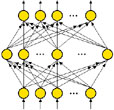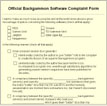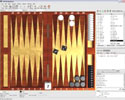
|
|
Rollouts
|

|
 Computers and Rollouts
Computers and Rollouts 
By Kit Woolsey (2000).
A history of using computers to roll out backgammon positions, from Expert Backgammon to TD-Gammon, Jellyfish, and Snowie. Some of the advantages and disadvantages of using computer rollouts. And a look to the future.
|

|
Rollouts 
By Douglas Zare (2002).
This article illustrates what information we can get from rollouts and what we can’t, and guides the process of choosing which rollouts to perform. It starts out simply, but introduces some complicated ideas in the examples.
|

|
 Variance Reduction
Variance Reduction
By David Montgomery (2000).
Variance reduction was a breakthrough in backgammon technology. A rollout of one hundred games using variance reduction might be just as accurate as a rollout of 2500 games done without variance reduction. What is "variance reduction"? How does it work? Why does it work?
|

|
 Questions and Answers about Variance Reduction
Questions and Answers about Variance Reduction
By David Montgomery (2000).
Jake Jacobs poses several interesting questions about variance reduction in computer rollouts and David Montgomery replies. How reliable is the "equivalent games" estimate? What is a "confidence interval"?
|

|
 Understanding Uncertainty
Understanding Uncertainty
By Chuck Bower (2001).
How to tell if your rollout results are significant. When comparing the results of two plays, each of which has an associated random uncertainty (standard deviation), a joint standard deviation needs to be calculated. Then you use a table to find out if repeating the rollout is likely to produce the same result.
|

|
 Sample Size and Computer Roll-Outs
Sample Size and Computer Roll-Outs
By DeWayne Derryberry (2002).
All sampling schemes, including computer rollouts, have a common statistical issue. Are apparent differences due primarily to chance variation, or a true difference, indicative of long-run behavior? This article presents some simple rules for determining when a rollout gives enough information that we can say one move is better than another.
|

|
 Articles on Rollouts
Articles on Rollouts
By Tom Keith.
Information on using and interpreting computer rollouts of backgammon positions. From the Backgammon Galore Forum Archive.
|

|
Simulating Positions
By Dan Heisman (1984).
Tips for performing rollouts (simulations) back in the days when rollouts were done by hand.
|
|
 |
|
Analyzing errors
|

|
 Nordic Open Seminar 2004
Nordic Open Seminar 2004
By Karsten Nielsen (2004).
For the Nordic Open 2004 I was asked to do the seminar and comment the finals live. The subject of the seminar was how to systemize your errors into groups.
|

|
 EMG Woes: Toward a More Consistent Normalization of Match-Play Errors
EMG Woes: Toward a More Consistent Normalization of Match-Play Errors
By Jeremy Bagai (2007).
EMG is a way of expressing match-winning chances (MWC) in a normalized form for easier comparison at different match scores. This article examines the history of the EMG normalization, highlights some dramatic inconsistencies within it, and discusses what might be involved in a new normalization which avoids those problems.
|

|
Normalizing Errors
By Douglas Zare (2006).
How do we measure the size of an error? How do we determine which errors are the most serious, and most worthy of attention? This article compares MWC (match winning chances) with the normalized equivalent, EMG (equivalent to money games), and looks at some of problems of trying to normalize errors.
|
|
 |
|
Programming
|

|
 Temporal Difference Learning and TD-Gammon
Temporal Difference Learning and TD-Gammon 
By Gerald Tesauro (1995).
TD-Gammon was the first computer program to achieve a level of play close to the best human players. The brains of the program is a neural network that was able to learn to play well by playing many times against itself and learning from the results. This article was originally published in Communications of the ACM, March 1995.
|

|
BKG, a Program That Plays Backgammon
By Hans Berliner (1977).
BKG was a computer program developed at Carnegie-Mellon University by Hans Berliner to play backgammon. It was the strongest program of its time. Here is a description of the inner workings of the program. BKG's evaluation procedure considers: blot danger calculation, blockading factor, running game, bearing off, and spacing men around the board.
|

|
Backgammon Computer Program Beats World Champion
By Hans Berliner (1980).
In July 1979, a backgammon computer program, BKG, beat the World Backgammon Champion, Luigi Villa, in a match to 7 points. This paper examines the scientific issues involved in constructing the program, an analysis of its performance, and the scientific significance of the win. We also present our SNAC method of constructing evaluation functions.
|

|
Computer Backgammon
By Hans Berliner (1980).
Backgammon is a good test of principles of artificial intelligence. BKG 9.8 is the first computer program to defeat a world champion at any board or card game. This article describes BKG and analyzes the 7-point match between BKG and world champion, Luigi Villa. (Originally published in Scientific American.)
|

|
 Reinforcement Learning: An Introduction
Reinforcement Learning: An Introduction
By Richard S. Sutton and Andrew G. Barto (1998).
The online version of a book published in 1998 by MIT Press. It covers learning techniques which can be applied to backgammon programs. One section describes Tesauro's TD-Gammon program. "One of the most impressive applications of reinforcement learning to date is that by Gerry Tesauro's to the game of backgammon."
|

|
Programming Backgammon Using Self-Teaching Neural Nets
By Gerald Tesauro (2002).
Previous papers on TD-Gammon have focused on developing a scientific understanding of its reinforcement learning methodology. This paper looks at programming shallow-depth search algorithms, and on TD-Gammon’s doubling algorithm, which is described in print here for the first time. From Artificial Intelligence journal, 2002.
|

|
TD-Gammon, A Self-Teaching Backgammon Program, Achieves Master-Level Play
By Gerald Tesauro (1993).
TD-Gammon is a neural network that is able to teach itself to play backgammon solely by playing against itself and learning from the results. Despite starting from random initial weights (and hence random initial strategy), TD-Gammon achieves a surprisingly strong level of play.
|

|
 Practical Issues in Temporal Difference Learning
Practical Issues in Temporal Difference Learning
By Gerald Tesauro (1992).
This paper is a predecessor to Tesauro's 1995 TD-Gammon article. It examines whether Sutton's TD(lambda) algorithm can be used to train a neural network to play backgammon. Tesauro found that with zero built-in knowledge a TD(lambda) trained network is able to learn to play the entire game of backgammon at a fairly strong intermediate level. This article was originally published in Machine Learning journal.
|

|
Neurogammon: A Neural-Network Backgammon Program
By Gerald Tesauro (1990).
Neurogammon 1.0 is a complete backgammon program which uses multilayer neural networks to make move decisions and doubling decisions. The networks were trained by back-propagation on large expert data sets. Neurogammon appears to play backgammon at a substantially higher level than conventional programs.
|

|
A Parallel Network that Learns to Play Backgammon
By Gerald Tesauro and T.J. Sejnowski (1989).
A class of connectionist networks is described that has learned to play backgammon at an intermediate-to-advanced level. The networks were trained by back-propagation learning on a large set of sample positions evaluated by a human expert.
|

|
 Motif Backgammon Player Engine
Motif Backgammon Player Engine
By Tom Keith (1996).
Motif is a Java Applet that you can play against on the internet. Here are some notes on how Motif chooses the moves it makes and how it learned to play.
|

|
 The Making of Bob's Backgammon
The Making of Bob's Backgammon
By Bob Landwehr (2000).
An overview the genetic algorithms used in Bob's Backgammon, and how they evolved through natural selection to improve over many generations in competition with other algorithms.
|

|
 The Neural Net Backgammon Programs
The Neural Net Backgammon Programs
By Jay Scott (1998).
A survey of many of the top backgammon programs and how they work. "These programs excel at strategic and positional judgment; they are less skilled in technical positions such as bearing in against an anchor." Part of the web site Machine Learning in Games.
|

|
Experiences in Evaluation with BKG, a Program That Plays Backgammon
By Hans Berliner (1977).
We here discuss insights gained about the structure of evaluation functions for a large domain such as backgammon. Evaluation began as a single linear polynomial of backgammon features. Later, we introduced state-classes, each with its own evaluation function. This improved the play, but caused problems with edge-effects between state-classes.
|

|
On the Construction of Evaluation Functions for Large Domains
By Hans Berliner (1979).
We present the SNAC method of encoding knowledge in a polynomial function. The most common use for such a function is to evaluate competing alternatives in a problem solving situation. The SNAC method was discovered during research on a program that plays backgammon. We show how to create sensitive evaluation functions, and how to avoid stability problems in nonlinear functions.
|

|
 Programming Backgammon
Programming Backgammon
By Tom Keith.
Many articles on tips and techniques for programming backgammon. From the Backgammon Galore Forum Archive.
|

|
Programming Computers to Play Backgammon
By Kit Woolsey and Kent Goulding (1982).
Backgammon has proven to be a difficult game to program successfully: even the finest programs will make moves that advanced intermediate players would sneer at. Why is it that backgammon programs do not play as well as chess or othello programs?
|

|
Coevolution of a Backgammon Player
By Pollack and Blair (1996).
Following Tesauro’s work on TD-Gammon, we used a 4000 parameter feed-forward neural network to develop a competitive backgammon evaluation function. However, no back-propagation, reinforcement or temporal difference learning methods were employed. Instead we apply simple hillclimbing in a relative fitness environment. Our results show co-evolution to be a powerful machine learning method.
|

|
Constructing an Evaluation Function for Playing Backgammon
By Anders Sjoqvist and Andre Stenlund (2011).
In this project we describe a few variations of the game backgammon. The player programs that we have developed are very primitive, but there are distinct tendencies revealing which players dominate the others. The winning player’s only strategy is to hit the opponent’s lone checkers, while protecting its own.
|

|
Gammon, an Approach to the Concept of Strategy in Game-Playing Programs
By William Bushey (1970).
Gammon is a computer program which plays Backgammon. A strategy is implemented as a set of tactical features. Moves are generated and evaluated on the basis of the degree to which the accomplish the tactics making up the current strategy.
|

|
Computer Beats Backgammon Champ
By Pete Bishop (1979).
Dr. Hans Berliner’s computer backgammon program was born when Berliner, world champion of correspondence chess 1968–72 and for 15 years one of the top 10 players in the country, returned to school for his doctorate.
|
|
 |
|
Computer Dice
|

|
 Official Backgammon Software Complaint Form
Official Backgammon Software Complaint Form
By Gary Wong (1998).
Form to fill out if you feel your backgammon software is cheating you or the site you are playing on has biased dice.
|

|
 Does Your Bot Cheat?
Does Your Bot Cheat?
By Bill Robertie (2006).
Why do people think bots cheat? Many are beginners who have never played serious backgammon. But they have managed to win a few sessions against friends and are convinced they are very fine backgammon players. This image is shattered the first time they play a decent backgammon program.
|

|
 Proving Your Bot Doesn't Cheat
Proving Your Bot Doesn't Cheat
By Bill Robertie (2006).
You don't have to take my word for it that bots don't cheat. The two best-selling commercial backgammon bots, Jellyfish and Snowie, both contains tools that allow you it to prove to yourself (if you're suspicious).
|

|
 Online Backgammon Dice
Online Backgammon Dice
By Hank Youngerman (2001).
In the many years I have played online, there have been repeated allegations that online dice are somehow not random. I have never found this to be the case. I'd like to devote this article to a discussion of the reasons people believe this, and the facts.
|

|
 FIBS dice analysis
FIBS dice analysis
By Patti Beadles (1995).
Do doubles on FIBS occur much more frequently than expected? There was speculation that this might happen if both players were using automatic rolls and moves. Patti investigates to see if this is true.
|

|
 How Rolls Are Generated at GammonSite
How Rolls Are Generated at GammonSite
By GammonSite (2004).
How the dice are generated. Why people see patterns in dice rolls. Common misconceptions about dice rolls in backgammon.
|

|
 Computer Dice Postings
Computer Dice Postings
By Tom Keith.
The most common and persistent theme of postings to rec.games.backgammon has to do with whether various backgammon programs cheat with their dice. Here is a small selection of those posts. (As far as I know, the dice in all major backgammon programs and on all backgammon play sites are random and fair.)
|
|
 |
|
Gnu Backgammon
|

|
 All About Gnu Backgammon
All About Gnu Backgammon 
By Albert Silver (2006).
Gnu Backgammon is a very strong computer program for playing and analyzing backgammon matches. It is available free for anyone to download and use. Albert Silver's guide takes you through all the features of the program and shows you how to use them. This is the best documentation available for the program.
|

|
 Getting started with GnuBG, a Guided Tour
Getting started with GnuBG, a Guided Tour
By Robert-Jan Veldhuizen (2006).
GnuBG is a program that plays backgammon and analyzes matches. This tutorial shows you how to download GnuBG and install it on your computer, how to play a game against the program, and how to analyze your matches.
|

|
 Gnu Backgammon FAQ
Gnu Backgammon FAQ
By Wiki.
Answers to frequently asked questions about Gnu Backgammon. What it is? Where do I get it? How do you use it?
|

|
 Gnu Backgammon Manual
Gnu Backgammon Manual
By Wiki.
Detailed information on using Gnu Backgammon: Introduction; Playing a game or match; Evaluation settings; Setting up a position; Working with matches; Rollouts; Customizing Gnu Backgammon; Advanced topics; Appendix.
|

|
 Articles on Gnu Backgammon
Articles on Gnu Backgammon
By Tom Keith.
Various articles and pointers on how to use Gnu Backgammon. From the Backgammon Galore Forum Archive.
|
|
 |
|
Snowie
|

|
 Snowie Home Page
Snowie Home Page
By Snowie Group.
Snowie is the second commercial neural-net backgammon program.
|

|
 Snowie 4: Back to the 80s
Snowie 4: Back to the 80s
By Albert Silver (2002).
Some observations on how Snowie 4 compares with its predecessor, Snowie 3. Snowie 4 seems to be far surer of itself in many positons where Snowie 3 was unable to give a confident evaluation.
|

|
 Snowie Parameter Settings
Snowie Parameter Settings
By Chuck Bower (2001).
How do the various settings (lookahead, truncation, bearoff database, live cube, search space, and play according to score) affect the time it takes to do a rollout in Snowie?
|

|
 Articles on Snowie Backgammon
Articles on Snowie Backgammon
By Tom Keith.
Articles and pointers on using Snowie Backgammon. From the Backgammon Galore Forum Archive.
|
|
 |
|
Other Bots
|

|
 The Michael Depreli Bot Comparisons
The Michael Depreli Bot Comparisons 
By Tom Keith (2011).
The results of two studies done by Michael Depreli comparing the playing the strength of the top bots: Jellyfish, Snowie, Gnu Backgammon, BG-Blitz, and Extreme Gammon.
|

|
 Bgblitz Home Page
Bgblitz Home Page
By Frank Berger.
One of the strongest neural-net backgammon players and analyzers.
|

|
 Making the World's Smallest Backgammon Expert
Making the World's Smallest Backgammon Expert
By Frank Berger and Markus Hervén (2009).
Is it possible to stuff a really challenging backgammon game into a mobile phone? It turns out the answer is yes, and here is how we did it.
|

|
 Articles about Jellyfish
Articles about Jellyfish
By Tom Keith.
Comments, questions, and answers about the Jellyfish backgammon program. From the Backgammon Galore Forum Archive.
|

|
 Programs that Play and Analyze Positions
Programs that Play and Analyze Positions
By Tom Keith.
Articles about programs that play and analyze backgammon games and matches. From the Backgammon Galore Forum Archive.
|
|

Last updated: 23 Sep 2024
|









![]()

